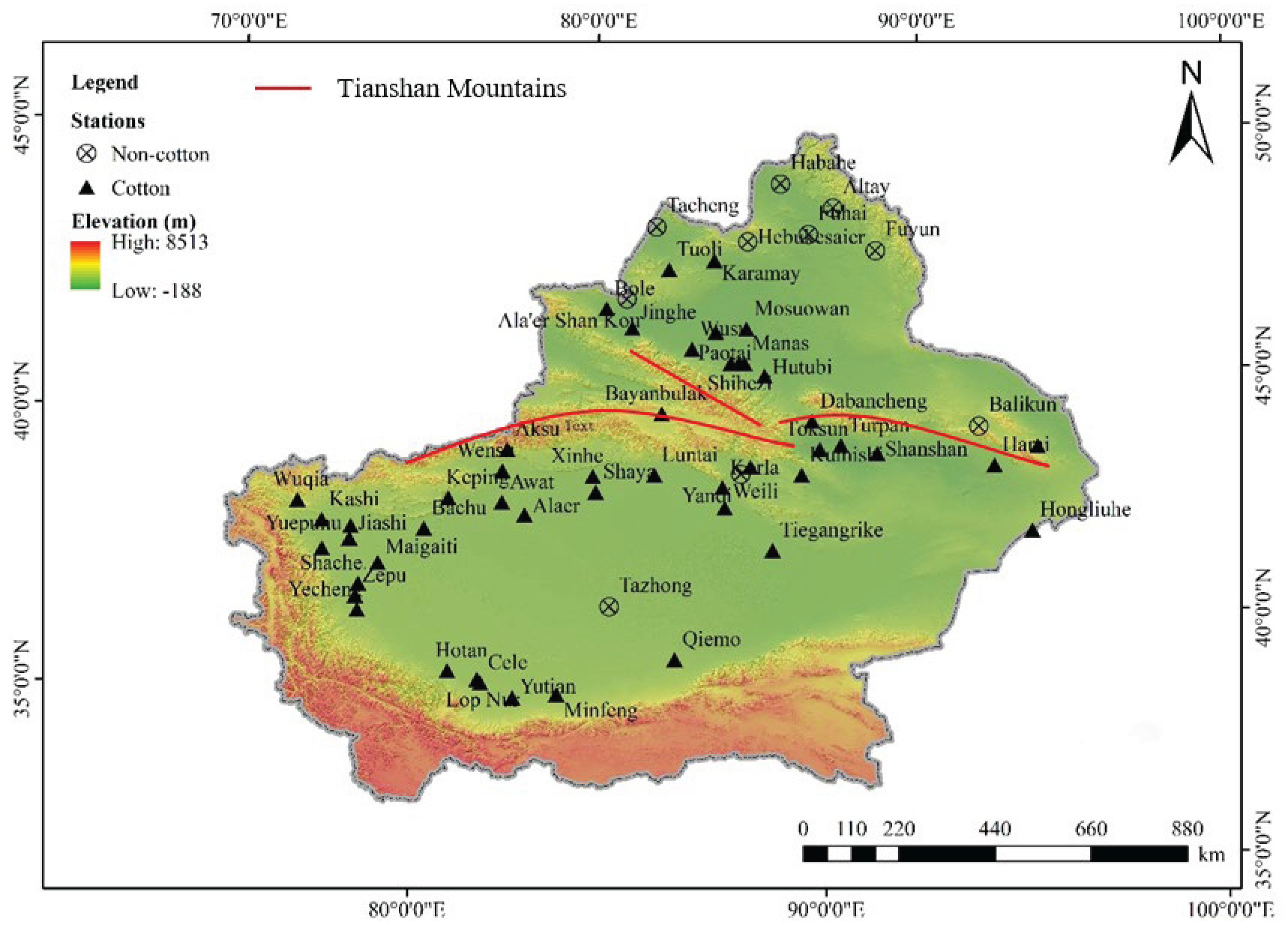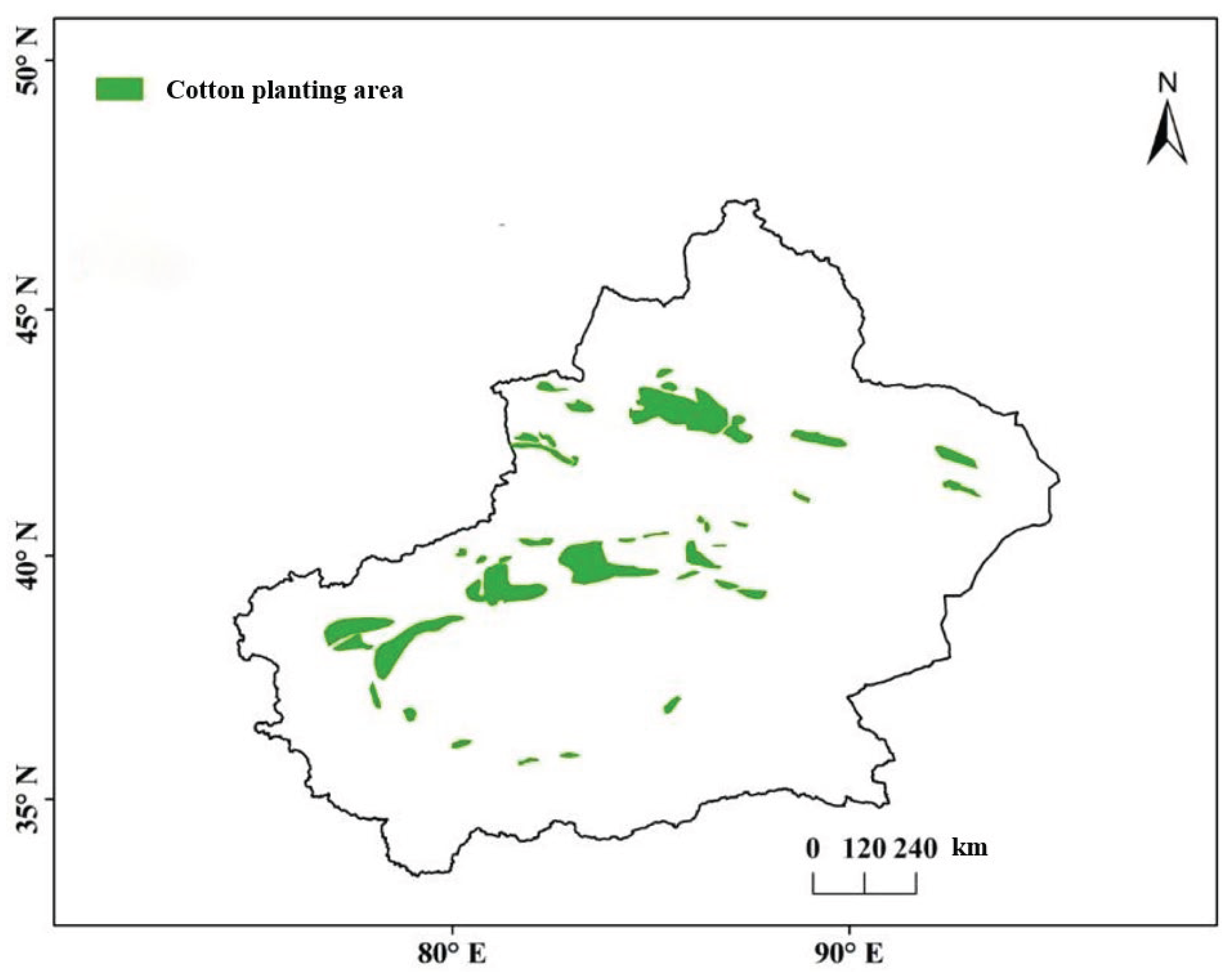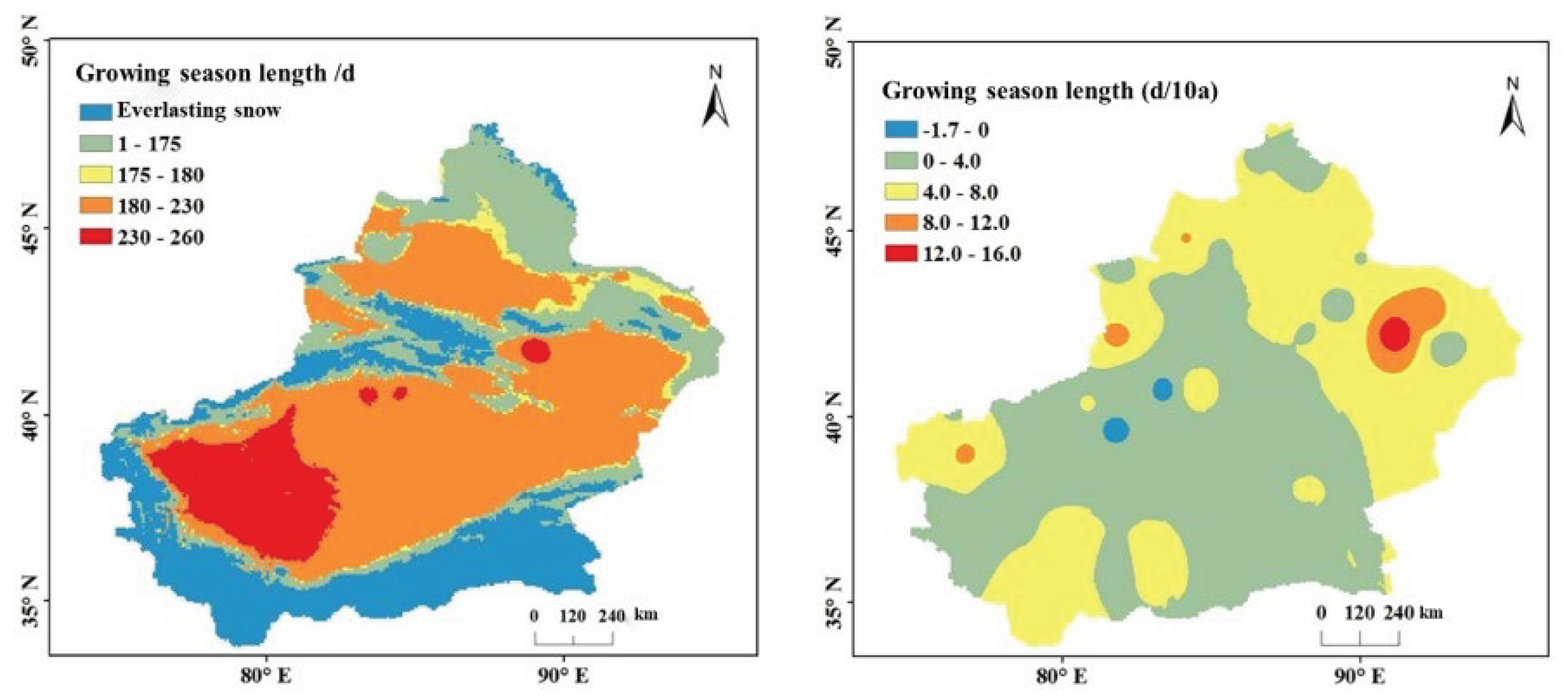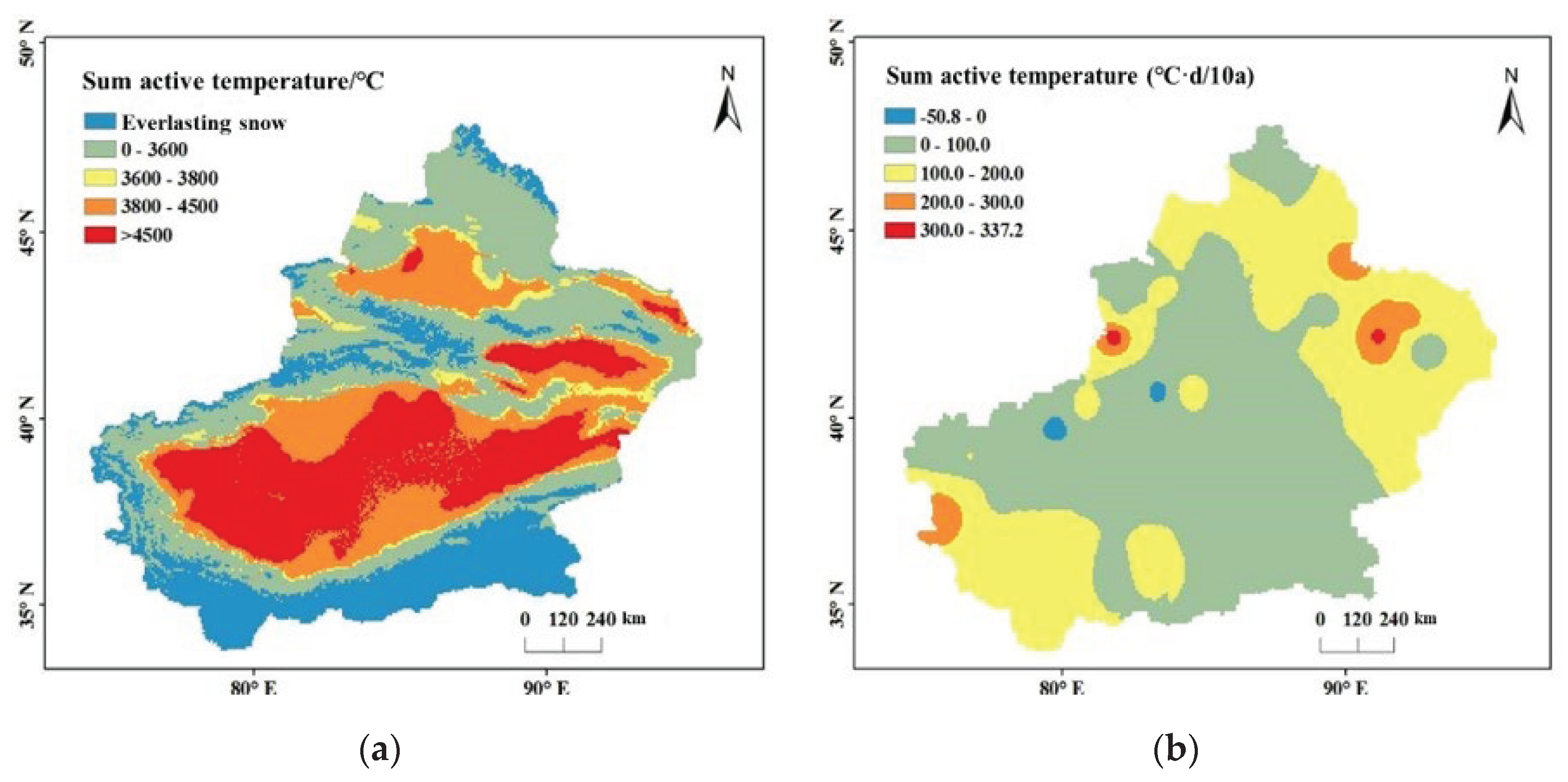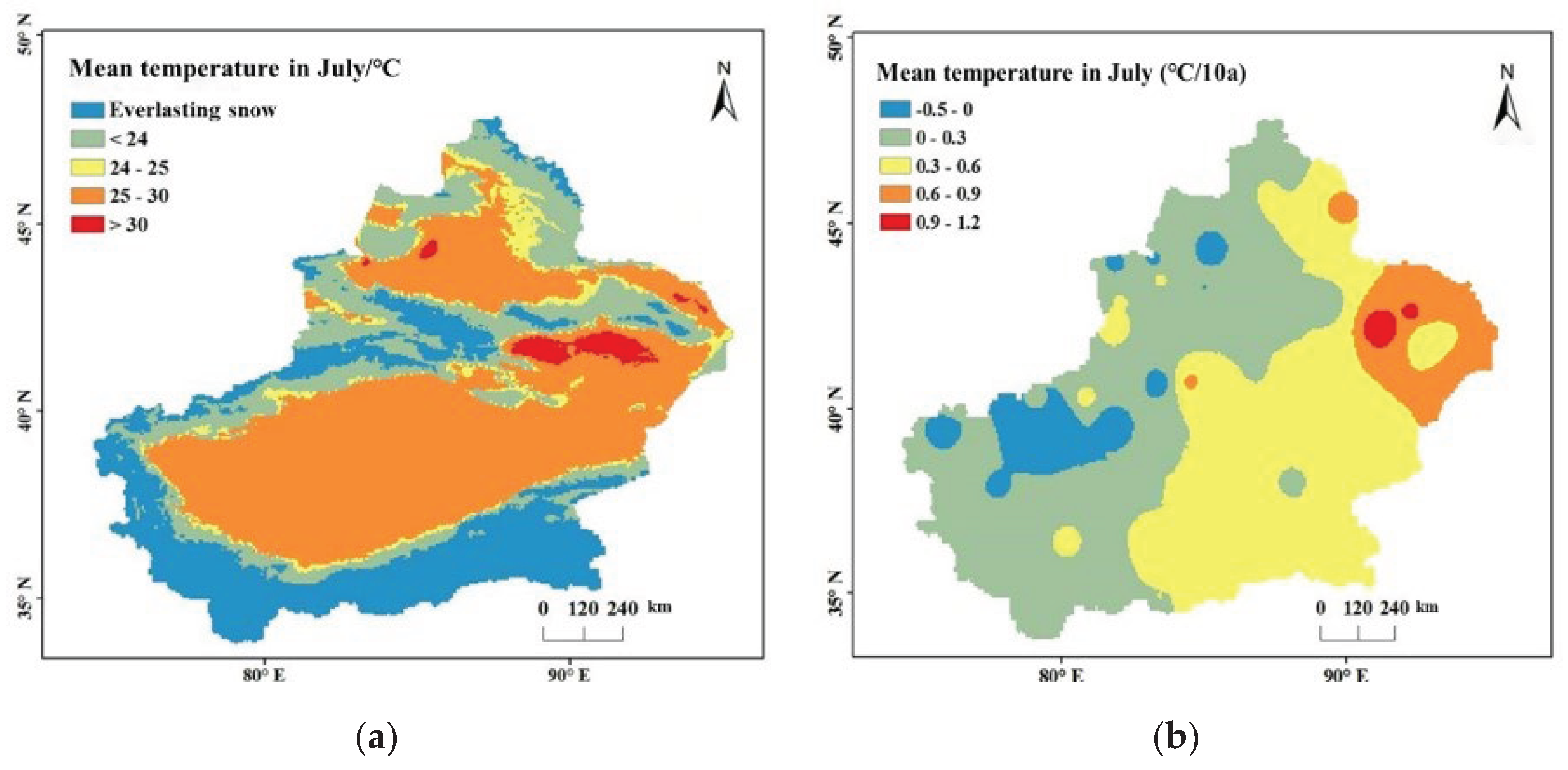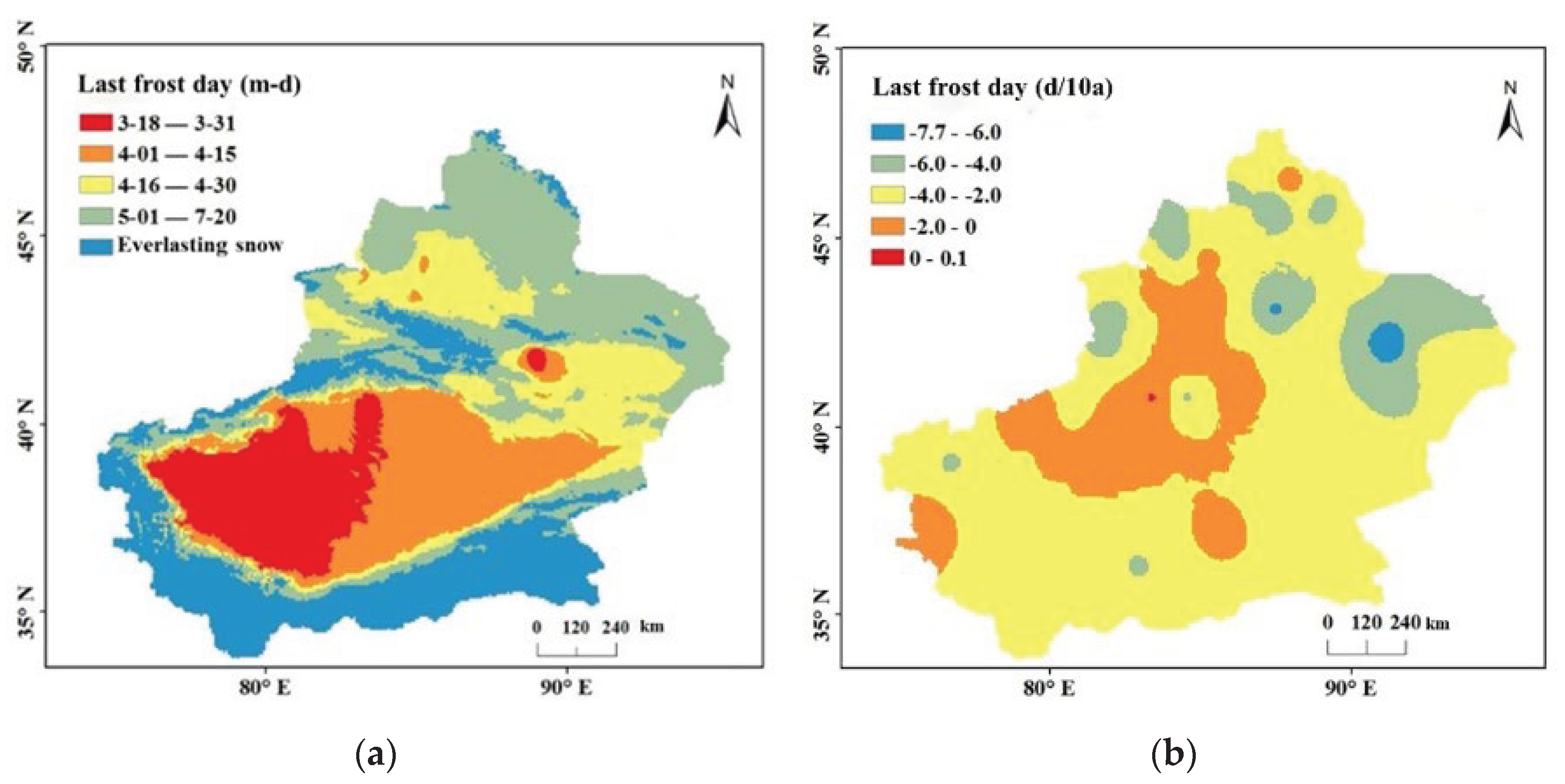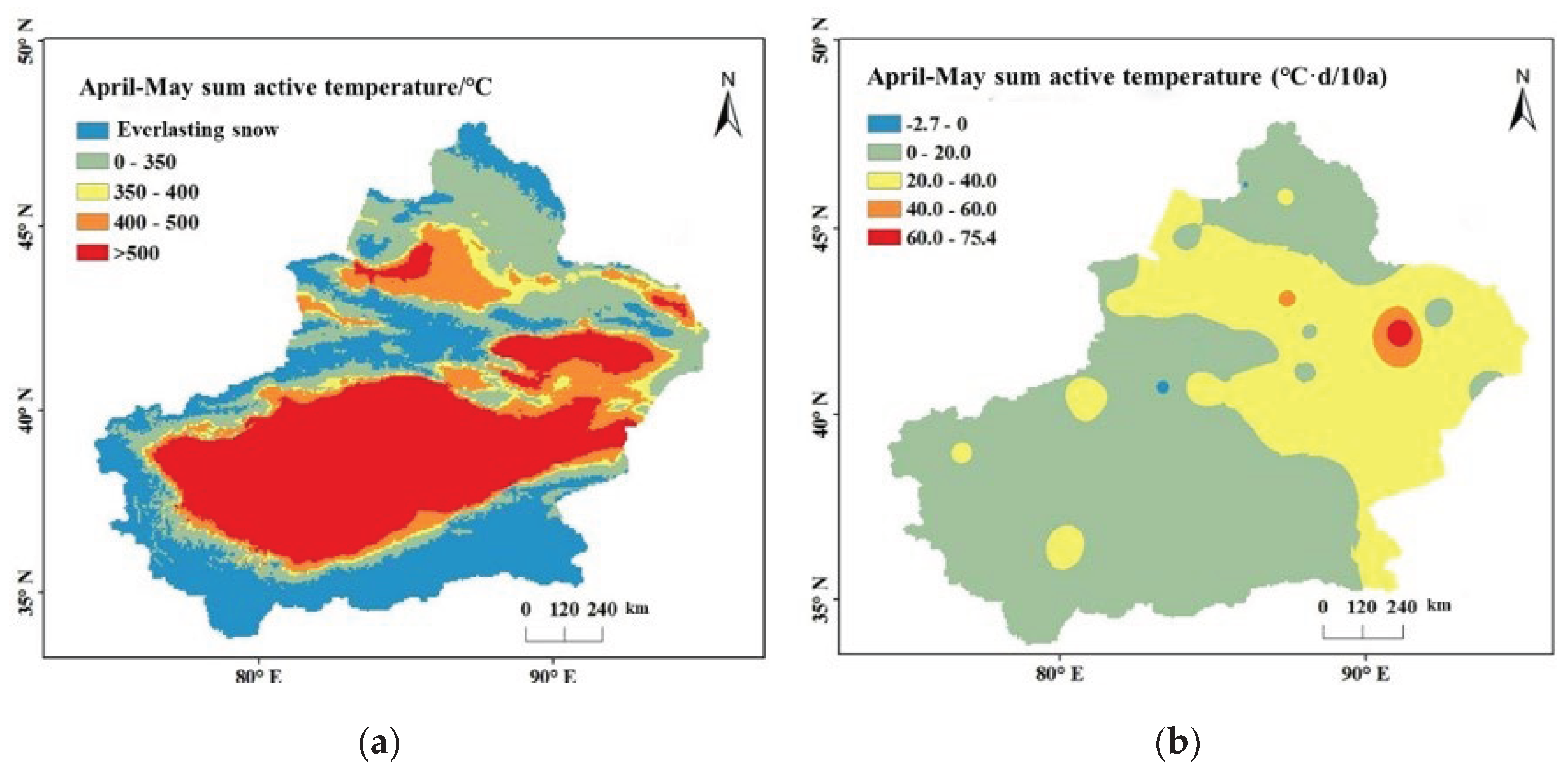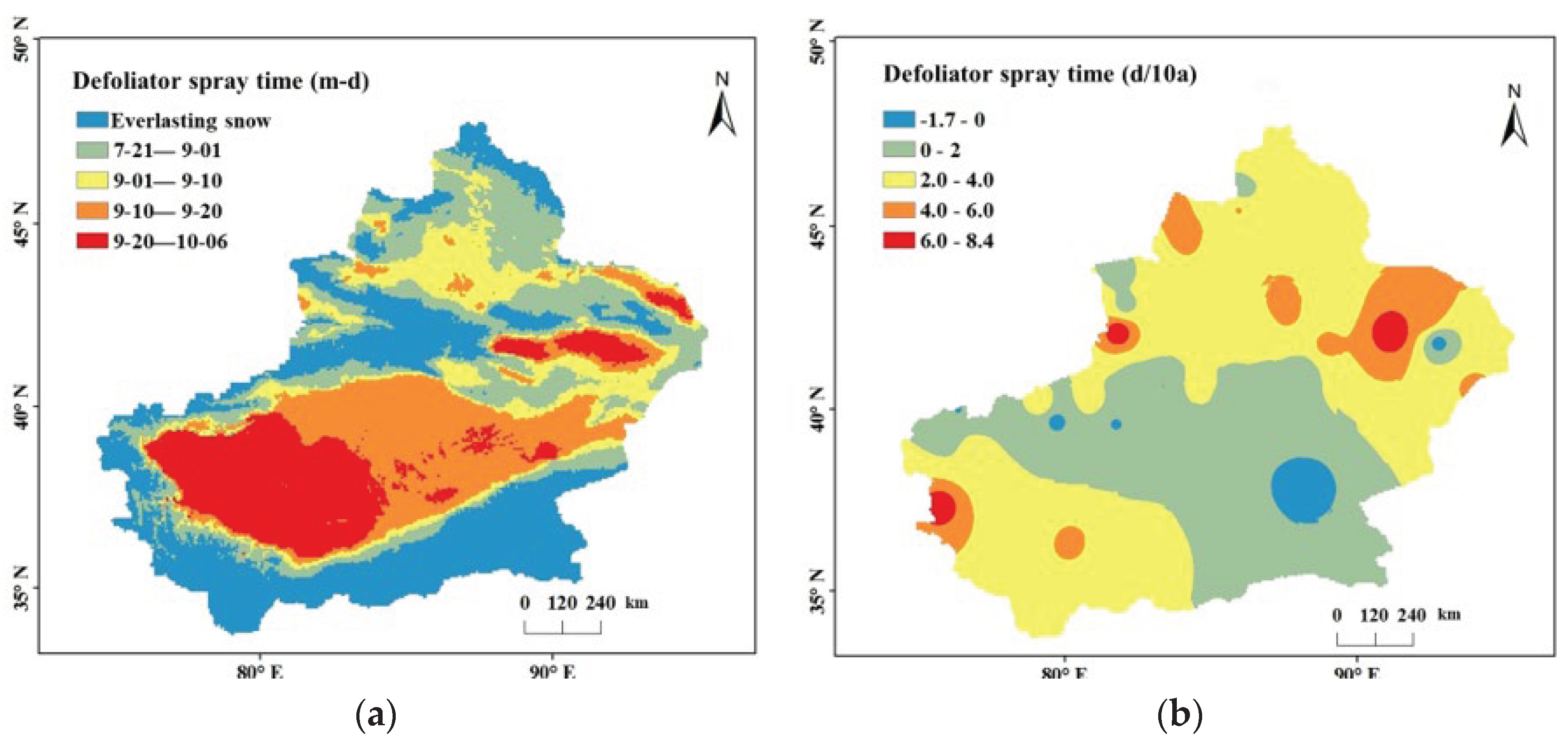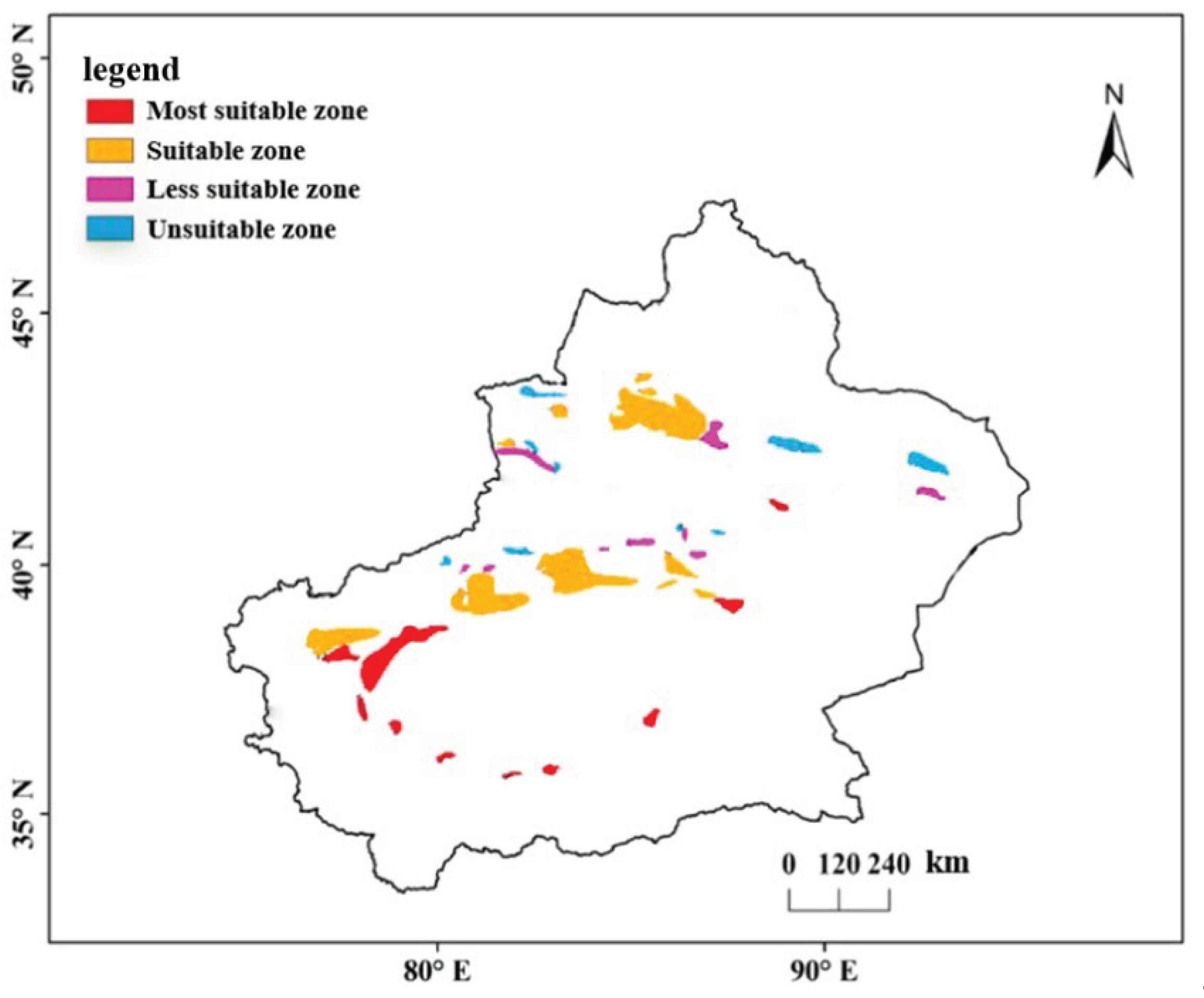1. Introduction
The Intergovernmental Panel on Climate Change (IPCC) Fourth Assessment Report stated that the global average surface temperature has risen by 0.74°C in the past 100 years [
1]. The observed and widely discussed trend of increasing average temperatures is influenced by geographical factors [
2], which may manifest differently in local climate ecosystems [
3,
4]. In particular, the agricultural sector should take this into consideration in agricultural planning [
5,
6].
Heat accumulation is a driver for crop growth and development, yield potential, water absorption, and stress [
7,
8]. Given that global climate change can pose significant threats to agriculture, numerous studies have reported changes in crop production potential [
9,
10], phenological shifts [
11], and changes in suitable crop zones [
12]. The most common climate indices used to assess these changes are typically sum of active temperature during key crop developmental stages. Additionally, for crop sensitivity to low temperatures, the occurrence of frost and the length of frost-free periods (i.e., growing season length) are important climate indicators that affect agricultural production. Detailed information on the temporal and spatial distribution of these climate indicators is needed when studying climate change and agricultural production issues.
Detailed research on these agricultural climate indicators helps to answer the following questions: (i) Will climate warming lead to uneven distribution of heat during the cotton growing period, thereby impacting cotton growth and development? (ii) Will climate warming delay or advance frost dates, resulting in changes in the actual growing season for cotton? (iii) What are the spatiotemporal patterns of climate indicators under climate warming? What impacts will they have on the existing suitable cotton areas? (iv) How can we develop strategies to mitigate the impacts of climate change by considering the climatic suitability zones for cotton?
Studies have reported that climate warming has caused the northward shift of agricultural climate zones in China, extended growing seasons, and expanded the suitable areas for warm-loving crops [
13,
14]. However, there are significant regional variations in climate change and its impact on agriculture [
15]. Some studies suggest that sum of active temperature ≥10°C, mean temperature of the warmest month (July), and frost-free period are the main meteorological indicators influencing cotton growth and development. Over the past few decades, the annual average temperature and mean temperature of the warmest month (July) in Xinjiang have shown a clear increasing trend, while sum of active temperature ≥0°C has significantly increased, and the frost-free period has significantly lengthened [
16,
17,
18]. Based on these indicators, Xinjiang's cotton-growing region has been further divided into suitable cotton areas, moderately suitable cotton areas, and risky cotton areas [
19,
20,
21]. Studies have shown that, influenced by changes in heat resources, the area of suitable cotton regions in Xinjiang has gradually increased, while the areas of moderately suitable and unsuitable cotton regions have decreased. At the same time, the area of mid-mature and early-mid-mature cotton regions in southern Xinjiang has been continuously expanding, while the areas of early-ripening and unsuitable cotton regions have decreased [
22,
23,
24]. However, in actual production, due to the complexity of cotton varieties, there are cases of unreasonable selection of maturity of varieties and blind expansion of planting areas in some regions, which have a significant impact on the quality and yield of cotton [
20,
21]. Therefore, studying the impact of climate change on the suitability of cotton cultivation is of great significance in addressing these issues.
The above-mentioned studies provide a theoretical basis and scientific evidence for the climate suitability zoning of cotton cultivation in Xinjiang. However, it is important to acknowledge the limitations of these studies:
(1) Lack of consideration for the climate resource requirements of machine-harvested cotton: Xinjiang is the region with the highest level of mechanization in cotton cultivation (National Bureau of Statistics data in 2023: the mechanized harvesting rate of cotton in Xinjiang has exceeded 81%, accounting for over 80% of the national total production). The aforementioned studies mainly divide suitable areas for cotton cultivation based on factors such as the length of the growing season, average July temperature, and sum of active temperature above a certain threshold. However, the specific climate resource requirements of machine-harvested cotton have not been adequately considered. It is necessary to develop targeted auxiliary indicators to divide the suitable regions for machine-harvested cotton cultivation in Xinjiang.
(2) Lack of quantitative research on the impact of mulching-induced warming on the suitability zones for different maturity cotton: According to statistics, as of 1994, 96.67% of the total sowing area in Xinjiang adopted mulching cultivation for cotton [
25]. Mulching not only increases soil temperature and moisture retention but also compensates for the temperature conditions required for cotton growth [
26,
27,
28]. Global climate warming and the use of mulching techniques in cotton cultivation can both affect the heat conditions required for cotton growth, which may influence the planting regions for cotton. However, most of the current research focuses on the suitability zoning of Xinjiang cotton under the background of global warming [
22,
23,
29].
In summary, it is necessary to address the limitations by conducting further research on the climate resource requirements of machine-harvested cotton and the quantitative effects of mulching-induced warming on the suitability zones for different maturity cotton. This will provide a more comprehensive and accurate scientific basis for the climate suitability zoning of cotton cultivation in Xinjiang. Such research can assist agricultural planners in better adapting to climate change and formulating appropriate crop cultivation strategies.
Our work is unique and significant in the following aspects: (i) We utilized meteorological data from 57 observation stations in Xinjiang with an 80% assurance rate, and applied ArcGIS meteorological interpolation software for small-scale grid interpolation. This resulted in more accurate and fine-grained interpolation results. (ii) We took into consideration the specific climate resource requirements of machine-harvested cotton and the effects of mulching on cotton growth. By incorporating auxiliary meteorological indicators for machine-harvested cotton and accounting for the compensating effects of mulching-induced warming, we were able to analyze the characteristics of the climate suitability zoning for machine-harvested cotton in Xinjiang in a more scientific manner.
2. Data Sources and Processing Methods
2.1. Overview of the Study Area and Data Sources
Xinjiang Uygur Autonomous Region is located in the hinterland of the Eurasian continent (34°25′-49°11′ N, 70°40′-96°18′ E), covering an area of approximately 1.66 million square kilometers, which accounts for 1/6 of China's total land area. It is an important passage of the ancient Silk Road. The region features a diversified topography, with a landscape pattern often referred to as "three mountains and two basins." From north to south, these include the Altai Mountains, Junggar Basin, Tianshan Mountains, Tarim Basin, and Kunlun Mountains. Divided by the Central Tianshan Mountains, Xinjiang is further classified into Southern Xinjiang and Northern Xinjiang (
Figure 1).
The region experiences a temperate continental climate characterized by dryness, abundant heat, and significant diurnal temperature variations. These climatic conditions are favorable for cotton cultivation, making Xinjiang the largest production area for high-quality commercial cotton in China.
For this study, meteorological data from 54 weather stations in Xinjiang for the period 1981-2020 were used, including average temperature, maximum temperature, and minimum temperature. Stations located in mountainous areas were excluded. The dataset consists of 48 weather stations in cotton-growing areas and 10 weather stations in non-cotton-growing areas (
Figure 1). The dataset represents average daily air temperature values at 2 meters above the ground level. The data were obtained from the China Meteorological Administration Data Sharing Service System (
http://data.cma.cn/). All selected weather stations had complete daily observation records throughout the study period. Digital elevation model (DEM) data were obtained from the GeoSpatial Cloud website (
http://www.gscloud.cn/), including a Xinjiang digital elevation model with a resolution of 90m*90m. To improve the interpolation accuracy, the DEM data were resampled using ArcGIS software (Esri, USA) to a resolution of 1 km*1 km. Both vector and raster data were projected using the Beijing-1954 geographic coordinate system and Beijing-1954 GK Zone 15N projection coordinate system.
2.2. Research Methods
2.2.2. Probalibity of exceedance
The probability of exceedance, also known as the exceedance probability, is the probability of a meteorological variable (such as rainfall, temperature, sunlight, etc.) reaching or surpassing a certain threshold within a specific time period. In the field of agricultural meteorology, calculating the exceedance probability of meteorological variables is important for assessing and predicting suitable conditions for crop growth and development. When analyzing agricultural climate issues using long-term climate elements, it is recommended to use a minimum exceedance probability of 80%. In this study, we used the “Extremes” package in R language (R version 4.3.1) to calculate the 80% exceedance probability of climate elements for the period 1981-2020.
2.2.3. Calculation of Heat Compensation Value under Plastic Film Mulching
Plastic film mulching in cotton fields can provide warming effects, especially during the seedling and budding stages of cotton growth. In order to explore the warming effect of plastic film mulching on cotton growth, researchers have proposed a calculation method to estimate the compensation value of effective temperature under plastic film mulching based on the temperature during the seedling and budding stages [
28,
30].
The calculation method includes the following steps:
Estimate the number of days (NL1 and NL2) required for sum of active temperature above 10°C during the initial day, seedling stage, and budding stage in Xinjiang region for each year.
Estimate the number of days (Nm1 and Nm2) for plastic film-mulched cotton during the seedling and budding stages based on the daily average temperature and the corresponding number of days for the open-field cotton using a trial calculation method. The calculation formula is as follows:
K is the compensation coefficient for the heat accumulation of plastic film-mulched cotton and effective temperature. The unit (℃·d) / (℃·d) can be omitted. For the seedling stage, K = 0.843, and for the budding stage, K = 0.207. NL and Nm represent the number of days for open-field cotton and plastic film-mulched cotton during a specific growth stage, measured in days. Tj and Tk represent the daily average temperature for open-field cotton and plastic film-mulched cotton during the same specific growth stage, measured in ℃.
- 3.
The equation for estimating the heat compensation value of effective temperature during the seedling and budding stages of plastic film-mulched cotton (ΔATM1 and ΔATM2) based on the number of days (Nm1 and Nm2) is as follows:
ΔATM is the heat compensation value of effective temperature of plastic film-mulched cotton, measured in ℃·d.
- 4.
The equation for estimating the total heat compensation value of effective temperature during the seedling and budding stages (ΣATM) is as follows:
ΣATM is the total heat compensation value of effective temperature during a specific growth stage of plastic film-mulched cotton, measured in ℃·d.
2.2.4. Zoning Indicators
The cumulative effective temperature ≥10℃ during the months of April to May and within the growing season is an important indicator for assessing the suitability of an area for cotton cultivation. It is positively correlated with bud formation and pre-frost flower yield. A higher cumulative temperature indicates a longer cotton growth period and higher yields of buds and flowers before the onset of frost. The absence of frost (from the last frost to the first frost) is a key factor limiting the length of the cotton growing season. The average temperature in July also plays an important role in the formation of high-quality fiber growth. The optimal timing for defoliant application, apart from being a factor limiting the growth and development time of cotton, also helps reduce impurities during mechanical harvesting, thus being a critical factor for the maturity and harvesting quality of mechanically harvested cotton [
4].
Referring to the “Technical Specifications for Machine-Harvested Extra-Long Staple Cotton Planting Operations(DB 65/T 2266-2019)” [
31] proposed by the Xinjiang Academy of Agricultural Sciences, the main indicators (
Table 1) and auxiliary indicators (
Table 2) for zoning machine-harvested cotton in Xinjiang have been established
2.3. Data Processing
2.3.1. Interpolation Methods
In this study, a mixed interpolation simulation method (MLR) is used to improve the accuracy of spatial interpolation for climate variables. Compared to other commonly used interpolation methods such as inverse distance weighting, spline interpolation, nearest neighbor, and trend surface method, the MLR method corrects the residuals in the overall interpolation process, enabling more accurate spatial interpolation. It has been widely used in recent years for fine-scale crop-climate suitability zoning.
Specifically, in this research, statistical tests are first conducted on the observed data. The estimated values of meteorological variables are treated as dependent variables, and multiple linear regression analysis is performed using independent variables such as longitude, latitude, and elevation derived from DEM data, to establish a geographic spatial model (
Table 3). The regression equation is then used to predict the dependent variable, obtaining the regression values. Next, the residuals of the dependent variable are computed, and local interpolation is performed on the residuals. The interpolated data of the residuals are then added to the regression values of the dependent variable to obtain a new fitted value, completing the spatial interpolation of zoning indicators. Finally, spatially interpolated raster maps of the six zoning indicators in Xinjiang for the period 1981-2020 are generated at a resolution of 1 km × 1 km.
The temporal variability of climate indicators is represented by linear trend estimation. The significance of the changes is assessed using the non-parametric Mann-Kendall test, and the statistical significance assessment adopts the Sen’s method [
32].
2.3.2. Climate Suitability Zoning
Based on the zoning spatial grid map, the combined weighting method of analytic hierarchy process and entropy weight method was used to determine the weights of zoning indicators for machine-picked cotton (
Table 4). The indices of each zoning were analyzed and overlaid spatially using the sum-and-product method to obtain the distribution map of climate suitability for machine-picked cotton planting in Xinjiang. With the support of GIS spatial analysis techniques, using the distribution data of cotton planting in Xinjiang (
Figure 2), a refined and quantitative zoning map of climate suitability for machine-picked cotton planting in Xinjiang and Xinjiang Production and Construction Corps was created.
According to research, it has been suggested that 1990 marked a turning point in temperature variation and the widespread adoption of plastic film technology [
33]. Therefore, the meteorological data from 1990 to 2020 was used in combination with the warming effect of plastic film for the zoning analysis.
2. Results and Analysis
2.1. Spatial and Temporal Distribution Characteristics and Trends of Heat Index
2.1.1. Length of Growing Season
The length of the growing season in Xinjiang shows a decreasing trend with increasing latitude and elevation. Regions with longer growing seasons are mainly distributed in the central and western parts of the Turpan Basin and the Tarim Basin, typically ranging from 230 to 260 days. In most of southern Xinjiang, the Junggar Basin, and the Ili River Valley, the length of the growing season ranges from 180 to 230 days. The shortest growing seasons are found in the high-altitude areas of the Altai Mountains, Tianshan Mountains, and Kunlun Mountains (above 4000m), where the length of the growing season is basically zero, insufficient to meet the heat requirements for cotton growth (
Figure 3a).
From 1981 to 2020, the frost-free period in 96% of the meteorological stations in Xinjiang showed an increasing trend, with an average extension of 4.5 days (
Figure 3b). The Shisanjianfang region had the fastest growth rate of the length of the growing season, with an increase of 12.0-16.0 days per decade (
P<0.01), accumulating a total extension of 49.2-65.6 days over 40 years. Most areas in southern Xinjiang showed an increase at a rate of 0-4 days per decade, with a cumulative extension of 0-16.4 days over 41 years. In most areas of northern Xinjiang, the rate of increase was 4.0-8.0 days per decade, with a cumulative extension of 16.4-32.8 days over 40 years. Additionally, in the areas of Alar and Kuche, where heat resources are abundant, the frost-free period is minimal and shows a rate of shortening at 0-1.7 days per decade, resulting in a cumulative shortening of 0-7.0 days over 40 years.
2.1.2. Sum of active temperature ≥10°C
The spatial distribution of sum of active temperature ≥10°C shows the overall pattern of "more in southern Xinjiang than in northern Xinjiang, more in plains and basins than in mountainous areas" (
Figure 4a). Due to the influence of elevation and latitude, the sum of active temperature ≥10°C decreases with increasing elevation and latitude. The areas with the highest sum of active temperature ≥10°C are mainly located in the central and western parts of the Tarim Basin in southern Xinjiang, with the Turpan and Hami basins having sum of active temperatures ≥4500°C, indicating abundant heat resources. In northern Xinjiang, except for the Karamay area with sum of active temperature ≥4500°C, most of the Junggar Basin has sum of active temperatures between 3800-4500°C. In the high-altitude areas of the Altai Mountains, Tianshan Mountains, and Kunlun Mountains, with elevations above 4000m, the sum of active temperature ≥10°C is zero.
About 96% of the stations show an increasing trend in sum of active temperature ≥10°C, with an average increase of 105.79°C (
Figure 4b). The stations with the fastest growth rate are Shisanjianfang and Yining, with an increase of 300-337.2°C•days per decade (P<0.01), accumulating a total increase of 1230-1381.7°C over 40 years. In southern Xinjiang, except for the Kuche and Keping areas, which decrease at rates of 0-50.8°C•days per decade, most areas show an increase at rates of 0-100°C•days per decade, resulting in a cumulative increase of 0-410°C over 40 years. In northern Xinjiang, except for the northern slopes of the Tianshan Mountains, which show an increase of 0-100°C•days, the central and eastern parts of the Junggar Basin show an increase at rates of 100-200°C•days per decade, resulting in a cumulative increase of 410-820°C over 40 years.
2.1.3. Average Temperature in July
There is little difference in the average temperature in July between southern and northern Xinjiang (
Figure 5a). The Karamay area, as well as the Turpan and Hami basins, have temperatures exceeding 30°C, while most areas in southern and northern Xinjiang have average temperatures ranging from 25 to 30°C in July. In high-altitude and cold regions such as the Altai Mountains, Tianshan Mountains, and Kunlun Mountains, the average temperature in July is below 0°C.
Around 80% of the stations show an increasing trend in the average temperature in July, with an average increase of 0.35°C (
Figure 5b). The Shisanjianfang region has the fastest growth rate in average temperature in July, reaching 0.9-1.2°C per decade (
P<0.01), with a cumulative increase of 3.69-4.92°C over 41 years. In southern Xinjiang, except for the Kuche, Wuqia, Bachu, Keping, Alar, and Shache areas, which decrease at rates of 0-0.5°C per decade, most areas show an increasing trend. The rate of change in the central and western parts of the Tarim Basin is smaller than that in the eastern region, reaching 0-0.3°C per decade (
P<0.01), resulting in a cumulative increase of 0-1.23°C over 40 years. In northern Xinjiang, except for the Alashankou, Karamay, Wensu, and Wusu areas, which decrease at rates of 0-0.5°C per decade, most areas show an increase at rates of 0-0.3°C per decade (
P<0.01), resulting in a cumulative increase of 0-1.23°C over 40 years.
2.1.4. Last Frost Date
The spatial distribution of the last frost date in Xinjiang shows an overall pattern of "earlier in southern Xinjiang than in northern Xinjiang, earlier in plains and basins than in mountainous areas". The earliest last frost date is mainly found in the Turpan Basin and the central and western parts of the Tarim Basin (
Figure 6a), generally occurring in mid to late March. In most areas of the Junggar Basin and the Ili River Valley, the last frost date occurs in mid to late April. The last frost date in the central and western parts of the Tarim Basin is earlier than in the eastern region. In the high-altitude and cold regions of the Altai Mountains, Tianshan Mountains, and Kunlun Mountains, frost occurs throughout the year due to the higher elevation.
Except for the Kuche station, where the last frost date is delayed at a rate not exceeding 0.1 days per decade (P<0.01), the last frost date at 96% of the meteorological stations shows an advancing trend, with an average advancement of 12.3 days (
Figure 6b). The Shisanjianfang region has the largest advancement in the last frost date, reaching 5.5-7.7 days per decade (P<0.01), with a cumulative advancement of 22.6-31.6 days over 40 years. In southern Xinjiang, the last frost date advances at a rate of 1.5-3.5 days per decade, resulting in a cumulative advancement of 6.2-14.4 days over 40 years. In northern Xinjiang, the last frost date advances at a rate of 1.5-5.5 days per decade, resulting in a cumulative advancement of 6.2-22.6 days over 40 years.
2.1.5. Sum of active temperature ≥10°C in April-May
The regions with the highest sum of active temperature ≥ 10°C in April-May are mainly distributed in southern Xinjiang, most areas of the Turpan and Hami basins, and the western part of the Junggar Basin (
Figure 7a). In most areas of the Junggar Basin in northern Xinjiang, the sum of active temperature ≥ 10°C in April-May ranges from 400 to 500°C. In the high-altitude and cold regions of the Altai Mountains, Tianshan Mountains, and Kunlun Mountains, the sum of active temperature ≥ 10°C in April-May is almost zero.
Around 96% of the stations show an increasing trend in the sum of active temperature ≥ 10°C in April-May, with an average increase of 19.11°C (
Figure 7b). The Shisanjianfang region has the fastest growth rate, reaching 60-75.4°C•days per decade (
P<0.01), with a cumulative increase of 246-309.14°C over 40 years. In southern Xinjiang, except for Kuche, which decreases at a rate of 0-2.7°C•days per decade, most areas show an increase at rates of 0-20°C•days per decade (
P<0.01), resulting in a cumulative increase of 0-82°C over 40 years. In northern Xinjiang, the areas with the highest growth rate of sum of active temperature above 10°C in April-May are mainly located in the northern slope of the Tianshan Mountains and the southern part of the Junggar Basin, reaching 20-40°C•days per decade (
P<0.01), resulting in a cumulative increase of 82-164°C over 40 years.
2.1.6. Timing of Defoliant Application
The spatial distribution of the latest timing for defoliant application shows an overall pattern of "earlier in northern Xinjiang than in southern Xinjiang, earlier in mountainous areas than in plains and basins" (
Figure 8a). In the Junggar Basin of northern Xinjiang, the latest timing for defoliant application is mainly concentrated in early September. In the Turpan Basin, Hami Basin, and the central and western parts of the Tarim Basin, the latest timing for defoliant application is in late September. Due to the higher elevation and perennial frost, the areas of the Altai Mountains, Tianshan Mountains, and Kunlun Mountains have the earliest timing for defoliant application.
In Xinjiang, 88% of the meteorological stations show a trend of delayed timing for defoliant application, with an average delay of 3 days (
Figure 8b). Among them, the regions with the highest rate of delay in the timing of defoliant application are Shisanjianfang, Zhaosu, and Tashikuergan, reaching 6-8.4 days per decade (
P<0.01), with a cumulative delay of 24.6-34.4 days over 40 years. Wuqia, Hami, Keping, and Alar regions show a trend of earlier timing for defoliant application, reaching 0-1.7 days per decade (
P<0.01), resulting in a cumulative advancement of 0-7 days over 40 years. In most areas of northern Xinjiang, the timing for defoliant application is delayed at a rate of 2-4 days per decade, resulting in a cumulative delay of 8.2-16.4 days over 40 years.
2.2. Cotton Mechanized Planting Suitability Zoning in Xinjiang
2.2.1. Results of Cotton Mechanized Planting Suitability Zoning in Xinjiang
The area of the most suitable zone for cotton mechanized planting in Xinjiang is 3.858×10
3 km
2, accounting for 18% of the total cotton mechanized planting area in Xinjiang. It is mainly distributed in areas such as Bachu, Shache, Pishan, Minfeng, Hetian, Yutian, Yutian, and Tiegangrike in southern Xinjiang. The area of the suitable zone for cotton mechanized planting is 13.657×10
3 km
2, accounting for 63.6% of the total cotton mechanized planting area in Xinjiang. The suitable zone covers a large proportion and includes both southern and northern Xinjiang, mainly distributed in cities such as Karamay, Wusu, Shihezi, Bole, Kuqa, Kuche, Aksu, Alar, and the eastern part of Kashgar. The area of the moderately suitable zone is 1.791×10
3 km
2, accounting for 8.3% of the total cotton mechanized planting area in Xinjiang. It is mainly distributed in areas such as Hami, Caijiahu, Urumqi, and the southern part of Yining. The area not suitable for cotton mechanized planting is 2.171×10
3 km
2, accounting for 10.1% of the total cotton mechanized planting area in Xinjiang, mainly distributed in areas such as Wenquan, Qitai, Balikun, Baicheng, and Yanqi (
Table 5;
Figure 9).
(1) Most suitable zone for cotton mechanized planting in Xinjiang
The most suitable zone has a growing season length greater than 200 days, with an average temperature in July exceeding 30°C, sum of active temperature above 10°C exceeding 3800°C, a final frost date in mid-late March, and an average sunshine duration of around 2700 hours. The favorable natural environment can meet the temperature requirements for the growth and development of cotton. The longer the growing season in this zone, the recommendation is to plant medium- to late-maturing varieties. The final frost date in southern Xinjiang is earlier than in northern Xinjiang, usually in mid- to late March, which is conducive to timely sowing of cotton. The average temperature in July in this area is above 25°C, promoting the normal development of cotton bolls. The sum of active temperature above 10°C in April-May exceeds 500°C, which can meet the requirements for cotton boll formation. Moreover, due to the abundant heat resources in this area, the first frost date is relatively late, allowing for a delayed timing for defoliant application, which is important for improving cotton yield and quality.
(2) Suitable zone for cotton mechanized planting in Xinjiang
The suitable zone has a wide distribution in both southern and northern Xinjiang, with no significant differences in sunshine conditions but variations in other heat indices. In the northern Xinjiang region, the final frost date is later than in southern Xinjiang (generally after April), resulting in a later planting time for cotton. The average sunshine duration is around 2680 hours, which is not significantly different from southern Xinjiang and can meet the normal requirements of cotton. In the western part of the Tarim Basin in southern Xinjiang, the average July temperature is slightly lower than in the western part of the Junggar Basin, and the sum of active temperature above 10°C is higher than in northern Xinjiang, which is conducive to the normal growth and development of cotton. In most areas of the Junggar Basin in northern Xinjiang, the growing season length is less than 200 days. Therefore, it is recommended to plant cotton varieties with shorter growth periods, such as medium- and early-maturing cotton. Due to the lower heat resources in northern Xinjiang and the earlier first frost date compared to southern Xinjiang, the timing for defoliant application is earlier in northern Xinjiang.
(3) Moderately suitable zone for cotton mechanized planting in Xinjiang
The moderately suitable zone has a growing season length less than 200 days, with a final frost date generally in mid-late April. Most areas in this region have sum of active temperature above 10°C in April-May between 400 and 500°C, which can basically meet the temperature requirements for cotton boll formation. The average July temperature in most areas is between 25 and 30°C, promoting the development of cotton bolls. Given that the climate conditions in this region can meet the normal growth and development of cotton, and considering the rational utilization of heat resources in Xinjiang and improving cotton quality, it is suggested to plant early-maturing or extra-early-maturing cotton in this zone.
(4) Unsuitable zone for cotton mechanized planting in Xinjiang
The Unsuitable zone has an average sunshine duration of 2600 hours, but the growing season length is less than 180 days, with sum of active temperature above 10°C between 3300 and 3700°C in April-May, which cannot meet the heat requirements for cotton growth, and it is prone to spring frost damage. It is recommended to plant other cash crops in this region.
2.2.2. Changes in the Zoning of Machine-Picked Cotton under Mulching-Induced Warming Mechanism
The widespread application of mulching film cotton planting technology in the early 1990s has had a significant impact on the entire cotton-growing region of Xinjiang. This article qualitatively analyzes the changes in the zoning area of different suitable zones for cotton and the sowing area between 1990 and 2020, based on cotton zoning indicators and temperature compensation values for mulching film. The aim is to explore the influence of mulching film technology on the zoning area for cotton.
Based on the Xinjiang Statistical Yearbook and the Xinjiang Corps Statistical Yearbook, the average sowing area for different suitable zones for cotton between 1981 and 1989, as well as between 1990 and 2020, was calculated.
Table 6 shows the changes in the sowing area for different suitable zones in Xinjiang before and after 1990. After 1990, the sowing area for the most suitable zone, suitable zone, moderately suitable zone, and unsuitable zone increased by 2.23×10
3 km², 2.75×10
3 km², -0.21×10
3 km², and -0.13×10
3 km² respectively. Among them, the area of the most suitable zone and suitable zone increased by 160.4% and 25.2% respectively, while the area of the moderately suitable zone and unsuitable zone decreased by 10.5% and 5.7% respectively.
Based on the zoning indicators and the temperature increase effect of mulching film, the average zoning area and sowing area for different suitable zones for mechanized cotton planting between 1990 and 2020 were analyzed(
Table 7). During this period, there was no significant difference between the sowing area and zoning area for the most suitable zone. The zoning areas for the suitable zone, moderately suitable zone, and unsuitable zone expanded by 2.15×10
3 km², -0.26×10
3 km², and -0.17×10
3 km² respectively, compared to the corresponding planting areas. Specifically, the zoning area for the suitable zone increased by 15.7% compared to the sowing area, while the zoning areas for the moderately suitable zone and unsuitable zone decreased by 14.5% and 7.8% respectively compared to the sowing area.
3. Discussion and Conclusion
The Xinjiang region is influenced by its unique topography of "three mountains and two basins," resulting in a spatial distribution pattern of heat resources (sum of active temperature≥10℃, average temperature in July, and length of the growing season) that is generally more abundant in the southern part of Xinjiang, and in the plains and basins rather than the mountainous areas. The latest spraying time for defoliant and the occurrence of the first frost reflect a spatial distribution characteristic of "earlier in northern Xinjiang and in mountainous areas compared to plains and basins."
The study also found that, due to global climate warming, the last frost dates in most areas of Xinjiang have advanced between 1981 and 2020. The sum of active temperature ≥10℃ during the entire cotton growth period, as well as the duration of emergence and flowering stages in April-May and the length of the growing season, have also increased. Additionally, sum of active temperature and average temperature in July have increased, leading to an expansion of the suitable cotton planting areas. These findings are consistent with previous research conclusions.
With the warming climate, the heat resources in Xinjiang have improved, resulting in an increasing cultivated area for the most suitable cotton zone (variety: mid-maturity cotton) and the suitable cotton zone (variety: mid-early maturity cotton), while the area for the unsuitable cotton zone (variety: extra early maturity cotton) has decreased. Similar conclusions were drawn by Li et al. (2015), who also noted a decreasing trend for the moderately suitable cotton zone (variety: early maturity cotton) and the unsuitable cotton zone. The observed increase in the cultivated area for the suitable cotton zone and a decrease in the area for the moderately suitable cotton zone and unsuitable cotton zone in this study are consistent with the changes in cotton zoning reported by Mai et al. [
14]. The study also found that compared to the period of 1981-1989, the sowing area for the most suitable cotton zone increased by 160.43% and the sowing area for the suitable cotton zone increased by 25.21% during the period of 1990-2020. Meanwhile, the sowing area for the moderately suitable cotton zone and unsuitable cotton zone decreased by 10.50% and 5.65% respectively. Overall, the total sowing area increased by 169.49% during the period. It is worth noting that in addition to the increasing heat resources in Xinjiang after 1990, the rapid development of the cotton industry and the construction of cotton infrastructure and investment in the cotton fields play a significant role in the expansion of the sowing area (China Historical Review, 2021; Xinjiang Statistical Yearbook, 2023) [
34,
35]. However, stimulated by market demand and policies, the moderately suitable cotton zone and risky cotton zone also expanded rapidly, leading to poor cotton yields and lower profitability, affecting the overall benefits of the Xinjiang cotton region [
36]. Particularly, since China's accession to the World Trade Organization (WTO) in 2001, there has been blind and unreasonable expansion of cotton planting zones, which has posed severe challenges and impacts on the imported cotton and international market for Xinjiang cotton.
It is worth noting that the extensive use of mulching film technology in the 1990s [
33]may have limited but significant positive effects on the expansion of mechanized cotton planting zones. To better demonstrate the impact of mulching film's temperature increase effect on zoning and sowing areas, we compared the zoning results from 1990-2020 with the actual sowing areas. It was found that under the mechanism of mulching film's temperature increase effect, the cotton plantable area in the moderately suitable zone and unsuitable zone decreased, while the plantable area in the suitable cotton zone increased. This trend is similar to the changing trend of the plantable area in cotton zones under the background of climate warming studied by Shkolnik et al. [
12] and Li et al. (2015) (comparing 1990-2015 with 1960-1989). However, for the mid-maturity cotton zone, which has the highest heat demand, the planting boundary and plantable area remain unaffected by the mulching film's temperature increase effect. This is possibly because the temperature compensation effect of mulching film primarily affects the early stages of cotton growth (seedling and budding stages), and there is an upper limit to the compensation of effective air temperature [
28]. Despite the mulching film's temperature increase effect, the most suitable cotton zone has abundant heat resources, but it is not enough to expand the plantable area. Furthermore, the results of the study lead to two key conclusions: (1) the zoning area for the suitable cotton zone (15.81×10
3 km²) is greater than the sowing area (13.66×10
3 km²), indicating that climate warming and the widespread application of mulching film technology have provided untapped potential for the expansion of mechanized cotton production in Xinjiang; and (2) the zoning areas for the moderately suitable cotton zone and unsuitable cotton zone (1.53×10
3 km² and 2.00×10
3 km², respectively) are smaller than the sowing areas (1.79×10
3 km² and 2.17×10
3 km², respectively), indicating the current expansion of mechanized cotton planting zones in the moderately suitable and unsuitable zones may be unreasonable and should be reduced.
In terms of zoning indicators, this study considered the characteristics of heat demand during the entire cotton growth period in Xinjiang for mechanized cotton planting. The indicators included the last frost date (related to cotton emergence), April-May sum of active temperature (related to cotton budding stage), average temperature in July (related to cotton flowering), the latest spraying time for defoliant (related to cotton quality), the length of the growing season (related to the length of the cotton growth period), and sum of active temperature of ≥10℃ (related to cotton maturity and the suitability of heat resources for planting). These indicators can meet the requirements for local cotton zoning in Xinjiang. Additionally, considering the impact of the mulching film's temperature increase effect on the suitable habitat for mechanized cotton, the mulching film temperature increase formula referred to the research results of Xiao et al. [
33]. Through trial calculations based on daily average temperatures during the seedling and budding stages of field-grown cotton and the duration of these stages, the formula estimates the number of days of seedling and budding stages for mulching film cotton and calculates the compensation value for effective air temperature. The formula takes into account the influence of temperature changes on soil temperature and has been validated through multiple years and trial sites [
37]. However, to ensure the timeliness and accuracy of the formula, further validation with experimental data is needed in the future.
It should be noted that the cultivation and distribution of cotton are not only influenced by climate factors mainly related to heat conditions but also closely related to soil, irrigation conditions, planting techniques, production costs, and market conditions [
38,
39]. Therefore, based on this research, it is crucial to comprehensively consider the integrated impact of natural, social, and economic factors on cotton production in order to develop more suitable cotton planting zoning and development plans that align with local agricultural production realities. This will be one of the key areas of future research on the development of the cotton industry in Xinjiang.
4. Conclusions
Based on the heat demand characteristics of machine-picked cotton, the study utilized grid-based calculations to analyze the spatiotemporal variations of heat resources in Xinjiang, China from 1981 to 2020, including sum of active temperature ≥10℃, growing season length, average temperature in July, frost-free period, sum of active temperature≥10℃ in April-May, and latest date of defoliant application. The study explored the temporal and spatial changes of agricultural heat resources in Xinjiang under the background of climate warming and the impact of mulching technology on the suitable areas and planting areas of machine-picked cotton. The following main conclusions were drawn:
(1) The heat resources in Xinjiang exhibited a spatial distribution pattern of "more in the southern part than the northern part, and more in the plains and basins than in the mountains". The latest date of defoliant application and occurrence of frost-free period showed a spatial distribution pattern of "earlier in northern Xinjiang than southern Xinjiang, and earlier in mountain areas than plains and basins". Under global climate warming, the frost-free period in most parts of Xinjiang advanced, the latest date of defoliant application postponed, and the growing season lengthened during 1981-2020. In addition, the cumulative ≥10℃ temperature in April-May, sum of active temperature≥10℃ during the entire growth period, and average temperature in July significantly increased.
(2) Compared with the period of 1981-1989, there were varying trends in the planting areas of different suitable regions during 1990-2020. In the context of climate warming, stimulated by market demand and policy guidance, the planting area of machine-picked cotton in the most suitable region in Xinjiang increased by 160.43%, the area in the suitable region increased by 25.21%, while the areas in the moderately suitable and unsuitable regions decreased to different degrees. As a result, the total planting area increased by 169.49%. However, there are hidden risks of unreasonable regional planning and blind expansion.
(3) Mulching technology has a limited but positive effect on the expansion of suitable areas for machine-picked cotton in Xinjiang. From 1991 to 2020, the warming effect of plastic film had little impact on the cultivable area in the most suitable cotton region, and the cultivable area in the suitable region expanded by 25% compared to the planting area. On the other hand, the cultivable areas in the moderately suitable and unsuitable regions decreased by 14.5% and 7.8%, respectively. This indicates that climate warming and the widespread use of mulching technology still provide untapped potential for the most suitable areas of machine-picked cotton in Xinjiang, bringing opportunities for expanding cotton production. However, it also highlights the need to reduce the planting area of machine-picked cotton in the moderately suitable and unsuitable regions, as the current regional planning still involves irrational expansion.
References
- Intergovernmental Panel on Climate Change (IPCC). Technical Summary. In Climate Change 2013 – The Physical Science Basis: Working Group I Contribution to the Fifth Assessment Report of the Intergovernmental Panel on Climate Change (pp. 31-116), 2014, Cambridge: Cambridge University Press. [CrossRef]
- IPCC, 2021: Summary for Policymakers. In: Climate Change 2021: The Physical Science Basis. Contribution of Working Group I to the Sixth Assessment Report of the Intergovernmental Panel on Climate Change [Masson-Delmotte, V., P. Zhai, A. Pirani, S.L. Connors, C. Péan, S. Berger, N. Caud, Y. Chen, L. Goldfarb, M.I. Gomis, M. Huang, K., Leitzell, E., Lonnoy, J. B.,R., Matthews, T. K., Maycock, T., Waterfield, O., Yelekçi, R., Yu, and Zhou B. (eds.)]. In Press. IPCC AR6 Working Group 1: Summary for Policymakers | Climate Change 2021: The Physical Science Basis.
- Terando, A.; Easterling, W. E.; Keller, K.; Easterling, D. R. Observed and Modeled Twentieth-Century Spatial and Temporal Patterns of Selected Agro-Climate Indices in North America. Journal of Climate 2012, 25(2), 473–490. https://journals.ametsoc.org/view/journals/clim/25/2/2011jcli4168.1.xml. [CrossRef]
- Kukal, M.S.; Irmak, S. U.S. Agro-Climate in 20th Century: Growing Degree Days, First and Last Frost, Growing Season Length, and Impacts on Crop Yields. Scientific Reports, 2018, 8, 6977. [Google Scholar] [CrossRef]
- Quaye, F.; Nadolnyak, D.; Hartarska, V. Climate change impacts on farmland values in the Southeast United States. Sustainability 2018, 10, 3426. [Google Scholar] [CrossRef]
- Jiang, T. C.; Wang, B.; Xu, X. J.; Cao, Y. X.; Liu, D. L.; He, L.; Jing, N.; Ma, H.J.; Chen, S.; Zhao, K.F.; Feng, H.; Yu, Q.; He, Y.B.; He, J.Q. Identifying sources of uncertainty in wheat production projections with consideration of crop climatic suitability under future climate. Agricultural and Forest Meteorology 2022, 319. [Google Scholar] [CrossRef]
- Skaggs, K. E.; Irmak, S. Long-term trends in air temperature distribution and extremes, growing degree days, and spring and fall frosts for climate impact assessments on agricultural practices in Nebraska. Journal Applied Meteorology Climatology 2012, 51, 2060–2073. [Google Scholar] [CrossRef]
- Edmar, I. E.; Fischer, G.; Velthuizen, H. V.; Walter, C.; Ewert, F. Global hot-spots of heat stress on agricultural crops due to climate change. Agricultural and Forest Meteorology 2013. [Google Scholar] [CrossRef]
- Zhao, C.; Liu, B.; Piao, S.; Wang, X.; Lobell, D.B.; Huang, Y.; Asseng, S. Temperature increase reduces global yields of major crops in four independent estimates. Proceedings of the National Academy of Sciences 2017, 114(35), 9326–9331. [Google Scholar] [CrossRef]
- Li, S.; Lu, Z.; Zhao, J.; Luo, M.; Chen, F.; Chu, Q. Changes in planting methods will change the potential distribution of rice in South China under climate warming. Agricultural and Forest Meteorology 2023, 331. [Google Scholar] [CrossRef]
- Hatfield, J.L.; Prueger, J.H. Temperature extremes: effect on plant growth and development. Weather Climate Extremes 2015, 10, 4–10. [Google Scholar] [CrossRef]
- Shkolnik, I. M.; Pigol'tsina, G. B.; Efimov, S. V. Agriculture in the arid regions of Eurasia and global warming: RCM ensemble projections for the middle of the 21st century. Russian Meteorology and Hydrology 2019, 44(8), 540–547. [Google Scholar] [CrossRef]
- Deng, Z. Y.; Zhang, Q.; Pu, J. Y. The impact of climate warming on crop planting and production in northwestern China. Acta Ecologica. Sinica 2008, 28(8), 3760–3768. Available online: https://kns.cnki.net/kcms/detail/detail.aspx?FileName=STXB200808033&DbName=CJFQ2008.
- Mai, J. F.; Liu, G. L. Modeling and predicting the effects of climate change on cotton-suitable habitats in the Central Asian arid zone. Industial Crops Products 2023, 191, 115838. [Google Scholar] [CrossRef]
- Chen, P. X.; Mao, W. Y. GIS-based spatial interpolation of air temperature in Xinjiang. Arid Land Geography 2012, 35(3), 438–445. [Google Scholar] [CrossRef]
- Li, J. L.; Zhang, S. Q.; Pu, Z. C.; Wang, M. Q.; Wang, S. L.; Zhao, S. Q. Refined spatio-temporal variation analysis of temperature in Xinjiang in recent 50 years. Journal Beijing Normal Univversity(Nature Science) 2013, 36(2), 229–237. [Google Scholar] [CrossRef]
- Pu, Z. C.; Zhang, S. Q.; Li, J. L.; Wang, M. Q. Spatiotemporal change of duration and sum of active temperature of temperature≥0℃in Xinjiang in recent 50 years. Arid Zone Research 2013, 30(5), 781–788. [Google Scholar] [CrossRef]
- Zhang, S. Q. The impact of global warming on frost-free periods from 1961 to 2010 in Xinjiang. Resources. Science 2013, 35(9), 1908–1916. https://api.semanticscholar.org/CorpusID:202171632.
- Xinjiang Agricultural Association. Cotton-planting areas division and corresponding countermeasures in north Xinjiang. Xinjiang Agricultural Science 1995, 32(1), 5–8. https://kns.cnki.net/kcms/detail/detail.aspx?FileName=XJNX501.001&DbName=CJFQ1995.
- Yao, Y. S. New discussion on cotton-planting areas division in Xinjiang. China Cotton 2001, 28(2), 2–5, https://kns.cnki.net/kcms/detail/detail.aspx?FileName=ZMZZ200102000&DbName=CJFQ2001. [Google Scholar]
- Huang, Z. K.; Cui, D. C. Ecological regionalization of cotton production in China. Cotton Science 2002, 14(3), 185–190. https://kns.cnki.net/kcms/detail/detail.aspx?FileName=MHXB200203013&DbName=CJFQ2002.
- Li, J. L.; Pu, Z. C.; Zhang, S. Q.; Wang M., Q.; Li X, J.; Xu W, X. Impact of Climate Change in Northern Xinjiang over the Past 52 Years on the Zoning of Cotton Planting Climate Suitability. Cotton Science 2015, 27(1), 22–30. [Google Scholar] [CrossRef]
- Pu, Z. C.; Zhang, S. Q.; Bin, J.; Dou, X. Y. The influence of climate warming on the zoning of cotton cultivation in Wuchang area of Xinjiang. Advances in Climate Change Research 2012, 8(4), 257–264. [Google Scholar] [CrossRef]
- Zhang, S. Q; Pu, Z. C.; Li, J. L; Li, X. J.; Ji, R. C.; Wang, M. Q.; Li, Y. Changes in zoning of cotton cultivation in southern Xinjiang under the background of climate warming. China Journal Agrometeorol 2015, 36(5), 594–601. https://kns.cnki.net/kcms/detail/detail.aspx?FileName=ZGNY201505009&DbName=CJFQ2015.
- Dai, L. The initiation and promotion of cotton planting and plastic film mulching in northern Xinjiang. Xinjiang Local Chrononicles 1995, 4, 42–43. https://kns.cnki.net/kcms/detail/detail.aspx?FileName=XJDF199504019&DbName=CJFQ1995.
- Gao, H.; Yan, C.; Liu, Q.; Ding, W.; Chen, B.; Li, Z. Effects of plastic mulching and plastic residue on agricultural production: A meta-analysis. Science of the Total Environment 2019, 651, 484–492. [Google Scholar] [CrossRef] [PubMed]
- Zhumilaiti, T.; Lin, T.; Yan, C. R.; Dilimaimaiti, D.; Deng F., N.; Wu, F. Q.; Kong, S.; Tang, Q. X. Effects of plastic film mulching duration on water and heat, cotton water consumption, and yield of cotton fields in Xinjiang. Transactions of the Chinese Society of Agricultural Engineering 2018, 34(11), 113–120. [Google Scholar] [CrossRef]
- Xiao, M.; Zhong, J.; Zhao, L. Studies on the correlation between cotton soil temperature and air temperature, and the compensating action of soil temperature increase in the mulched cotton field on effective air accumulation temperature. Journal of Xinjiang Agricultural University 1998, 1(4), 5–9. https://kns.cnki.net/kcms/detail/detail.aspx?FileName=XJNY804.001&DbName=CJFQ1998.
- Li, Y. C; Xie, G. H.; Li, X. J.; Yao, Y. L. Cotton zoning in Aksu area of Xinjiang based on GIS. China Journal Agrometeorol 2007, 28(4), 450–452. https://kns.cnki.net/kcms/detail/detail.aspx?FileName=ZGNY200704027&DbName=CJFQ2007.
- Xiao, M.; Zhong, J. P.; Li, B. C.; Zhao, L. The effect and pattern of soil temperature increase in cotton field mulched with plastic film and the modification on the GOSSYM simulation model. Journal of Xinjiang Agricultural University 1997, 20(4), 32–39. https://kns.cnki.net/kcms/detail/detail.aspx?FileName=XJNY704.008&DbName=CJFQ1997.
- The cultivation technique rules for mechanically harvested of upland cotton cultivars.(DB 65/T 2266-2019), https://www.waitang.com/report/201600.html.
- Salmi, T.; Määttä, A.; Ruoho-Airola, P.; Tuija, T.; Amnell, T. Detecting Trends of Annual Values of Atmospheric Pollutants by the Mann-Kendall Test and Sen's Solpe Estimates the Excel Template Application MAKESENS. Publications on Air Quality, 2002, 31. (PDF) Detecting Trends of Annual Values of Atmospheric Pollutants by the Mann-Kendall Test and Sen's Solpe Estimates the Excel Template Application MAKESENS (researchgate.net).
- Qiao, D.; Bao, L. L.; Lin, T.; Lin, T.; Tang, Q. X. Analysis of the Application and Contribution of Mulching Technology in Typical Mulching Areas of Xinjiang. Journal Anhui Agriculyural Science 2023, 51(7), 226–230. [Google Scholar] [CrossRef]
- China's Historical Review: 60 Years of Development and Retrospect on Xinjiang Cotton Industry. [2021-03-26]. https://www.sohu.com/a/457450257_501405.
- Xinjiang Statistical Yearbook., 2022, https://tjj.xinjiang.gov.cn/tjj/tjnj/jump.shtml.
- Shi, X.; Wang, C.; Zhao, J.; Wang, K.; Chen, F.; Chu, Q. Increasing inconsistency between climate suitability and production of cotton (Gossypium hirsutum L.) in China. Industrial Crops Products 2021, 171, 113959. [Google Scholar] [CrossRef]
- Zhao, L.; Zhong, J. P.; Zhao, F. Q.; Bi, S. J.; Duan, R. P.; Liu, Z. Y. GOSSYM and applications under the condition of north Xinjiang cotton region. Journal of Xinjiang Agricultural University 1999, 22(1), 43–50. https://kns.cnki.net/kcms/detail/detail.aspx?FileName=XJNY901.008&DbName=CJFQ1999.
- Ndamani, F.; Watanabe, T. Developing indicators for adaptation decision-making under climate change in agriculture: A proposed evaluation model. Ecological Indicators 2017, 76, 366–375. [Google Scholar] [CrossRef]
- Li, N.; Yao, N.; Li, Y.; Chen J., Q.; Liu D., L.; Biswas, A.; Li, L. C.; Wang, T. X.; Chen, X. G. A meta-analysis of the possible impact of climate change on global cotton yield based on crop simulation approaches. Agricultural Systems 2021, 193, 103221. [Google Scholar] [CrossRef]
|
Disclaimer/Publisher’s Note: The statements, opinions and data contained in all publications are solely those of the individual author(s) and contributor(s) and not of MDPI and/or the editor(s). MDPI and/or the editor(s) disclaim responsibility for any injury to people or property resulting from any ideas, methods, instructions or products referred to in the content. |
© 2024 by the authors. Licensee MDPI, Basel, Switzerland. This article is an open access article distributed under the terms and conditions of the Creative Commons Attribution (CC BY) license (http://creativecommons.org/licenses/by/4.0/).
